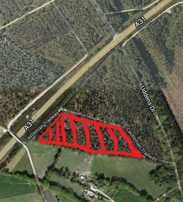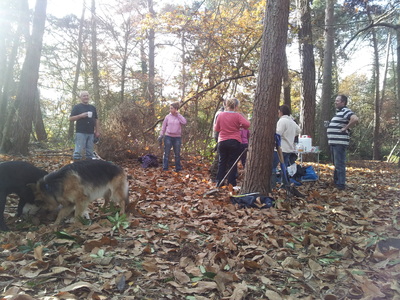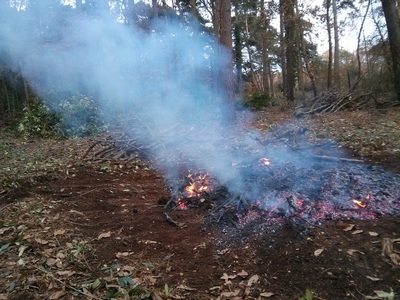Sunday 8th December 2013 Christmas Work Party
Our first work party running it ourselves, we were blessed with great weather and an amazing 30 volunteers attending all or part of the day.
Previously we have worked under the supervision of the Forestry Commission or Dorset Countryside, so we were delighted so much was achieved under our own steam!
It was a great opportunity to celebrate the work achieved throughout the year and with donated sausage rolls, mince pies, homemade biscuits and sausages cooked on the fire, nobody went hungry!
Following consultation with Andrew Norris from the Forestry Commission we continued our project in Cannon Hill South to cut and burn the invasive Rhododendron.
Where did it come from?
Rhododendron ponticum is a non-indigenous evergreen shrub. It was introduced into the British Isles around 1763 as a cultivated flowering plant and was widely planted in gardens, parks and estates (At Cannon Hill it lined Uddens Drive, the former driveway to Uddens House). It was also planted extensively in Victorian hunting estates, particularly in western coastal areas, under woodland canopies and on heathland areas to
provide shelter for game species.
Why is it a problem?
Although the flowers are attractive, rhododendron has few other attributes that offset the negative impact it can have on a site that it invades . It is an aggressive coloniser that reduces the biodiversity value of a site; it obstructs the regeneration of woodlands and once established is difficult and costly to eradicate. As bushes mature and occupation of an invaded site increases, physical access can be reduced by the sheer density and size of the plants present, and the cost of some management operations (e.g. felling) can increase if the bushes require treatment first. Mature bushes also act as a prolific seed source for invasion of adjacent areas, and are a continued source of new plant material into areas successfully cleared.
How will we get rid of it?
We have joined forces with the Forestry Commission who have already started working to remove it in Cannon Hill North with a combination of mechanical means and spraying with herbicide. The mechanical flailing causes a great deal of mess and needs good access to the site.
The spraying is time consuming and very difficult on the larger plants.
The method we are taking on the South side is to cut and burn it. It will regrow from the cut stumps, but this can be easily sprayed by the Forestry Commission where the weakened plants are more likely to succumb to the herbicide.
Previously we have worked under the supervision of the Forestry Commission or Dorset Countryside, so we were delighted so much was achieved under our own steam!
It was a great opportunity to celebrate the work achieved throughout the year and with donated sausage rolls, mince pies, homemade biscuits and sausages cooked on the fire, nobody went hungry!
Following consultation with Andrew Norris from the Forestry Commission we continued our project in Cannon Hill South to cut and burn the invasive Rhododendron.
Where did it come from?
Rhododendron ponticum is a non-indigenous evergreen shrub. It was introduced into the British Isles around 1763 as a cultivated flowering plant and was widely planted in gardens, parks and estates (At Cannon Hill it lined Uddens Drive, the former driveway to Uddens House). It was also planted extensively in Victorian hunting estates, particularly in western coastal areas, under woodland canopies and on heathland areas to
provide shelter for game species.
Why is it a problem?
Although the flowers are attractive, rhododendron has few other attributes that offset the negative impact it can have on a site that it invades . It is an aggressive coloniser that reduces the biodiversity value of a site; it obstructs the regeneration of woodlands and once established is difficult and costly to eradicate. As bushes mature and occupation of an invaded site increases, physical access can be reduced by the sheer density and size of the plants present, and the cost of some management operations (e.g. felling) can increase if the bushes require treatment first. Mature bushes also act as a prolific seed source for invasion of adjacent areas, and are a continued source of new plant material into areas successfully cleared.
How will we get rid of it?
We have joined forces with the Forestry Commission who have already started working to remove it in Cannon Hill North with a combination of mechanical means and spraying with herbicide. The mechanical flailing causes a great deal of mess and needs good access to the site.
The spraying is time consuming and very difficult on the larger plants.
The method we are taking on the South side is to cut and burn it. It will regrow from the cut stumps, but this can be easily sprayed by the Forestry Commission where the weakened plants are more likely to succumb to the herbicide.

One more work party and we should have cleared the area marked in red.
We hope to complete this in the early part of 2014 to allow the FC to get in and spray any regrowth.
This will let more sunlight onto the woodland floor creating a glade with improved biodiversity and better access for all to enjoy.
To find out more about the problems and control methods regarding Rhododendron, the Forestry Commission have a report about it here (Where a lot of the above information originated).
We hope to complete this in the early part of 2014 to allow the FC to get in and spray any regrowth.
This will let more sunlight onto the woodland floor creating a glade with improved biodiversity and better access for all to enjoy.
To find out more about the problems and control methods regarding Rhododendron, the Forestry Commission have a report about it here (Where a lot of the above information originated).















